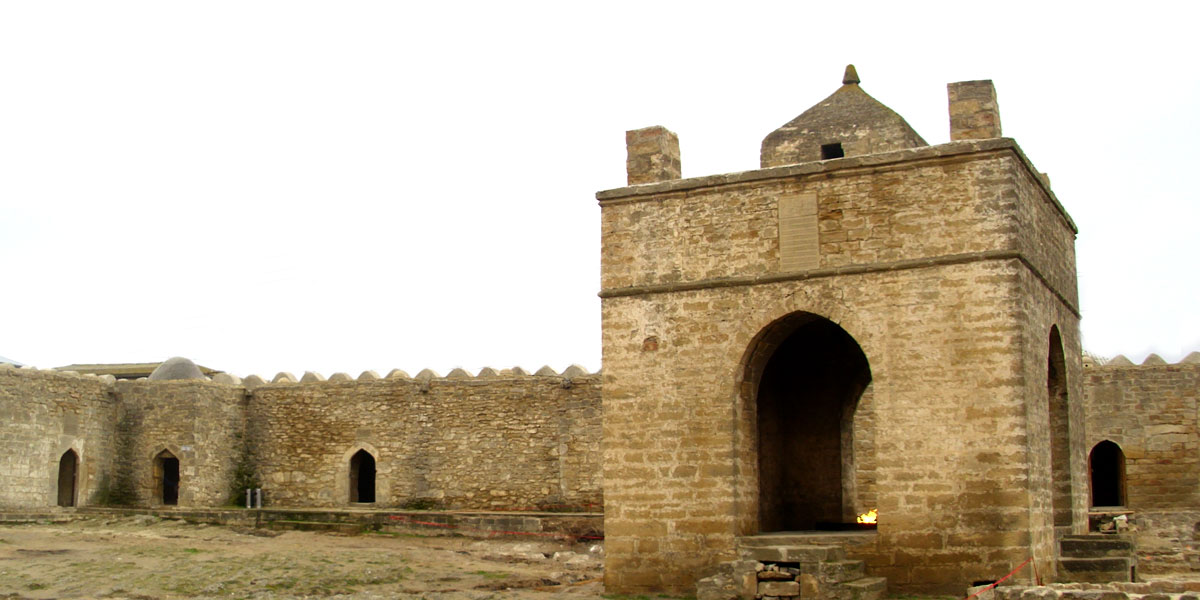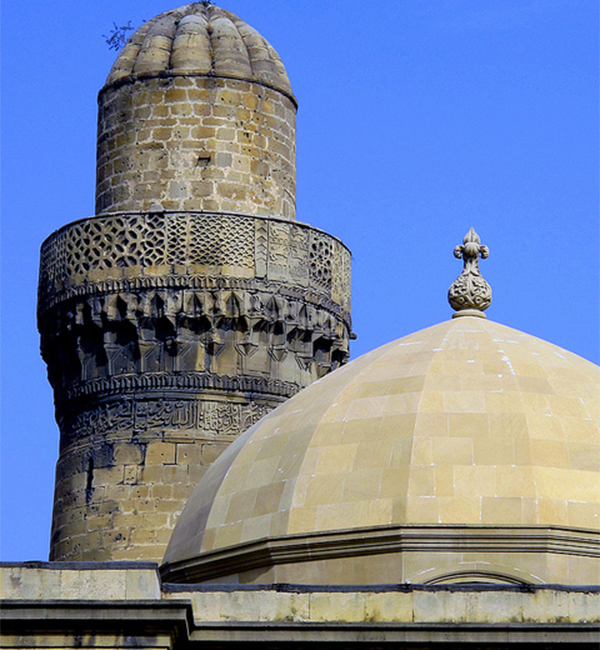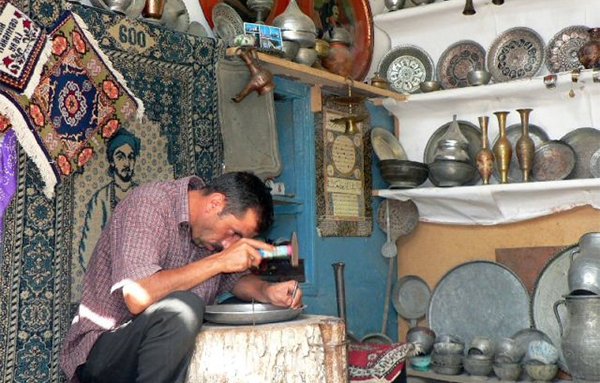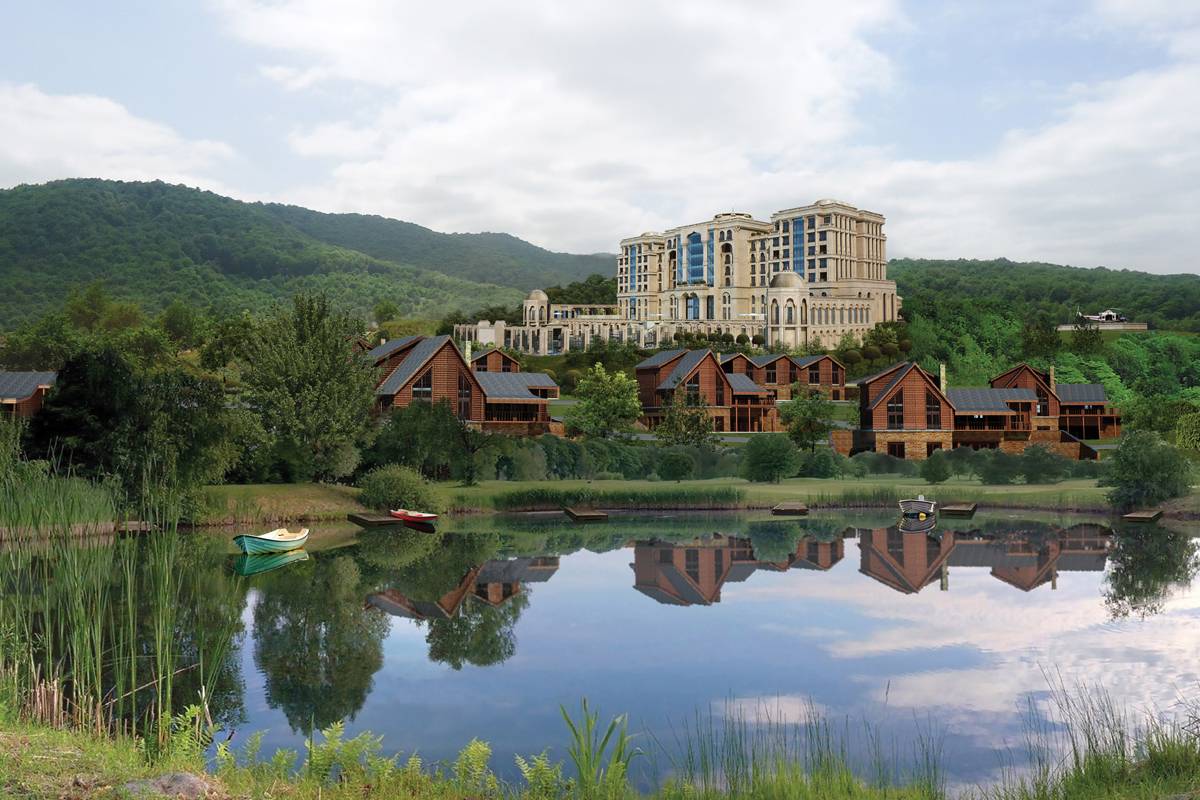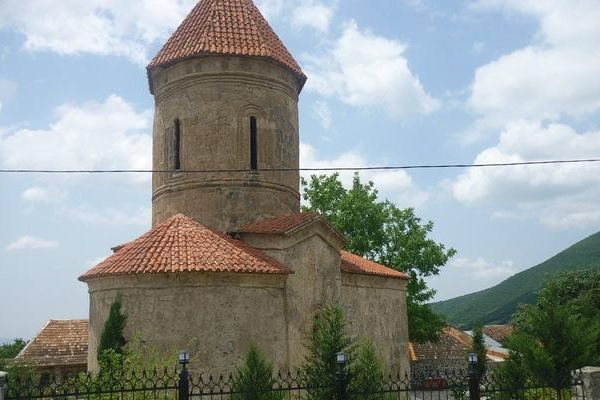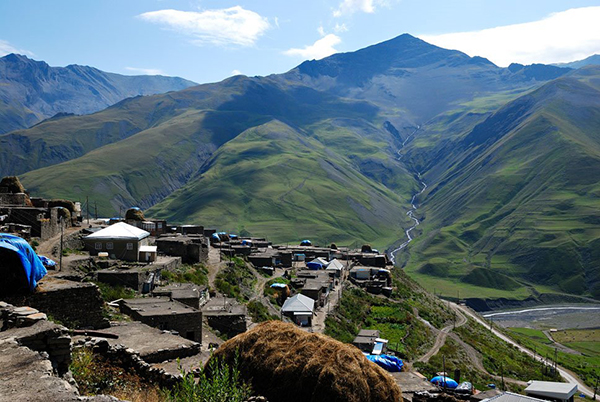Day 1. Baku. Absheron peninsula
Panorama of Baku from the height of the mountainous part of the city and at the TV Tower gives a clear picture regarding the scale and contrasts of Baku. The city has a shape of an amphitheater descending down to the Caspian Sea. The excursion covers the central part (downtown) of the city demonstrating the most interesting historical and architectural sites.
The territory of Icherisheher is merely 22 hectares, which is just a small fraction of the total area of Baku (44,000 ha). However, the saturation with architectural and historical monuments dictates the need of having a special hike to this part of the city and makes this part of Baku, perhaps the most interesting one to explore. Maiden Tower (XII century), the Palace of the Shirvanshahs (XV century), Synykh Gala castle, Caravanserai and Juma Mosque are among the must-see places and this is not a complete list of showplaces of the old Baku.
The part of Azerbaijan located on the Absheron peninsula is generally called Absheron. Absheron distinguishes itself with hot summers and mild winters and is surrounded on 3 sides by sea – in other words, it is best suited for the lovers of seaside resorts. Developed infrastructure in the region (extensive network of roads, numerous hotels and recreation areas of different categories, sandy beaches, international airports) makes it the best from the point of recreation, recuperation and receiving foreign guests.
A large number of unique historical monuments, including the numerous temples, castles, fortresses and watchtowers of the Middle Ages cause large interest among both tourists and local Azeris. Among these monuments, we can point the fire-worshipers temple in the village of Surakhani. Temple o Fire (Ateshgah) is an ancient religious building, erected on the site of natural gas output. The Temple was rebuilt in the XVIII century. Former cells, where pilgrims from all over the world were residing centuries ago, now host a museum containing lots of unique and original exhibits.
Day 2. Baku – Shamakhi – Lahij – Gabala
Now we are leaving for the northwestern part of Azerbaijan through the Caucasus mountains. Dry landscape around Baku is getting replaced by dense forests and mountains.
On the way we will visit the city of Shamakhi where the largest mosque of the Caucasus – “Juma” Mosque and the tomb of the rulers of the Shirvanshahs – “Yeddi Gyumbyaz” are situated. Next trip brings us to the village of Lahij. Lahij is a unique monument of the Persian urban architecture and art of antiquity. It was founded approximately in the V century BC. The etymology of the village’s name comes from the Lahij tribe moved here from Iran (IV-V centuries). Crossing the Araz river they settled in the mountainous part of Azerbaijan and named the emphasized settlement in the name of their homeland. The city is part of the international tourist route on the Great Silk Road and is famous for its artisans’ workshops. A trip to the city of Gabala, hotel accommodation and overnight come next.
Day 3. Gabala – Sheki
Breakfast. Departure to the town of Sheki. Sheki is one of the most famous and ancient places of Azerbaijan. It is located 700 meters (2,297 ft) above the sea level and is surrounded by mountains and oak forests like an amphitheater. This ancient city has been known as a center of silk production and an important passage post on the Silk Road for quite a long period of time. It is also suggested that the name of the city dates back to the ethnonym of the Saks who reached the territory of Azerbaijan in the VII century BC. We start our tour with a visit to Sheki Khan Palace (XVIII century) with magnificent frescoes and exquisite handmade window ornaments. Then we will visit the shop where artisans prepare famous Sheki windows called “Shebeke.” We will also visit the local shop where Sheki sweets are cooked.
Day 4. Sheki – Kish – Baku
A visit to the Albanian temple in the Kish village which is located not far from Sheki. According to the legend this church is the very first Christian church built not only on the territory of the Caucasian Albania but also in the whole region of Transcaucasia. This place is also remarkable for another feature: mass burial found here during the archeological excavations proves that the buried people heavily differ from the present inhabitants of the region by their structure. Scientists and researchers who studied the relics described the former natives as tall persons with blond hair and blue eyes. Famous Norwegian explorer Thor Heyerdahl who visited this part of Azerbaijan arrived at a decision that the Albanians were the ancestors of the Vikings; he also presumed that Albanians immigrated from these places to the North long ago. The church was restored on the money of the Norwegian Government in 2003 as a result of personal efforts of Thor Heyerdahl. Here, near the territory of the church you can find a memorial bust in honor of the famous explorer as a gratitude from local residents and the state. The next is departure to Baku, arrival in the city and accommodation at the hotel.
Day 5. Baku – Guba
A trip to the north of Azerbaijan, to the city of Guba. Guba is located 600 m above the sea level, in the north-eastern slopes of the Shahdagh mountain which belongs to the Greater Caucasus mountains and on the banks of Gudialchay river and is just 168 km apart from Baku.
Thanks to a good location and developed infrastructure Guba district is one of the most beloved and renowned tourist destinations in Azerbaijan.
Gachrash site which is famous for its shady woods, Tengealti gorge with tempestuous flows of Velvelechay river, well-known Afurja waterfall which is included in the list of the “Monuments of Azerbaijani Nature” – these are the favorite places of Guba visitors.
The district has a peerless mountainous village of Khynalyg, situated 2500 m above the sea level. The population of the village is a separate ethnic group with its own unique language. There is another original mountainous village of Gryz not far from Khynalyg. Overnight in Guba.
Day 6. Guba – Baku – Gobustan
Breakfast. Departure to Baku. Arrival in Baku and accommodation at the hotel. Excursion to Gobustan. Gobustan is a historical and architectural reserve in the open air with unique cave paintings of Neolithic times. There are more than 6 thousand of petroglyphs dating back to 12,000 years. The patterns reflect the life of the Stone Age people – mostly hunting, recreation and dances that were accompanied by the melodious sounds of “Gaval dashi” (a stone with deep resonating sound). There were formed numerous carves thanks to huge rocks. These carves served as shelters and hideaways that simultaneously helped people to wait out the bad weather conditions.
A visit to the Museum of Gobustan.
Day 7
Breakfast at the hotel. Preparations for the departure. Transfer to the airport. End of the tour
The tour price
|
| Price (in USD) |
|
Number of tourists
|
SNG |
DBL
|
| 2 |
$1 885 |
$1 670 |
| 4 |
$1 308 |
$1100 |
| 6 |
$1 100 |
$885 |
| 8 |
$1000 |
$810 |
| 10 |
$955 |
$736 |
| 12 |
$906 |
$687 |
| 15 |
$885 |
$666 |
| 20 |
$829 |
$610 |
| 25 |
$795 |
$576 |
| 30 |
$796 |
$578 |
| 35 |
$777 |
$558 |
| 40 |
$762 |
$544 |
The price includes:
Accommodation at the hotel (with breakfasts) in accordance with the program
Transportation services according with the program
Guide services
Museum entrance tickets
The price does not include:
Airfare
Insurance
Visa
Lunch and dinner
Alcoholic beverages
Note: the tour price considers the accommodation in comfortable hotels with 3* rate. Depending upon customer’s wish, the hotel rate can be enhanced to a higher rate (with extra charge).
The map and routes
Baku – Shamakhi – Lahij – Gabala – Sheki – Kish – Baku – Guba – Baku
| Days |
Directions |
Distance, km/ml |
Duration, +/- traffic |
| Day 1 |
Baku – City tour – Absheron peninsula |
60 / 38 |
40 minutes |
| Day 2 |
Baku – Lahij – Shamakhi – Gabala |
300 / 188 |
4 hours 20 minutes |
| Day 3 |
Gabala – Shamakhi |
140 / 88 |
2 hours 25 minutes |
| Day 4 |
Sheki – Kish – Baku |
350 / 219 |
5 hours |
| Day 5 |
Baku – Guba |
170 / 106 |
2 hours 35 minutes |
| Day 6 |
Guba – Baku – Gobustan |
300 / 188 |
4 hours 20 minutes |
| Day 7 |
Baku – transfer to the airport |
20 / 12 |
20 minutes |
Visa
Only the citizens of Turkey and Israel are able to obtain the visa on arrival at the international airports of Azerbaijan. Visa to Azerbaijan is not required for the citizens of CIS member states (except Turkmenistan). The citizens of other countries must obtain a visa prior to arrival in Azerbaijan via the Azerbaijani consulate in their home country or to get electronic visas through our travel agency. To obtain a visa, please contact our managers at least 6 weeks prior to arrival in Azerbaijan.
Hotel
The tour price is designed for 3 or 4 star hotels. This category can be upgraded to 5* in accordance with the request of tourists. Breakfast is included in the price of all the hotels. Laundry services are available at extra charge. Internet in the regions is limited and in some hotels is regrettably not available. In Baku hotels internet is fully available and is free of charge in the most of them. Check-in time is 02:00 pm check-out time is 12:00 noon. Early check-in and late check-out is available on request and at an additional cost.
Practical Information
Foreign Exchange Market: Information regarding exchange rates can be obtained by clicking the following link: http://www.cbar.az/
Local currency: Azerbaijani manat (AZN)
Recommended exchange currency: USD/EUR
Where to exchange your currency: upon arrival at the airport your guide will give precise information on where and how you can exchange your cash money to local currency
Availability of ATMs: in big cities only
Credit Cards acceptance: in big cities only
Climate
|
Jan |
Feb |
Mar |
Apr |
May |
Jun |
Jul |
Aug |
Sep |
Oct |
Nov |
Dec |
|
Avg. temperature |
6 |
5 |
8 |
15 |
18 |
30 |
32 |
30 |
20 |
17 |
12 |
8 |
|
Avg. max. temperature |
10 |
8 |
12 |
19 |
22 |
30 |
35 |
37 |
25 |
21 |
16 |
12 |
|
Avg. min. temperature |
3 |
2 |
4 |
10 |
13 |
25 |
30 |
33 |
16 |
13 |
8 |
6 |
|
Avg. Rainy Days |
4 |
5 |
3 |
3 |
4 |
3 |
5 |
4 |
3 |
4 |
2 |
5 |
|
Avg. Snowy Days |
0 |
3 |
1 |
0 |
0 |
0 |
0 |
0 |
0 |
0 |
0 |
0 |
Protection and Vaccinations
Are not necessary
Power Supply and Plugs
Detailed information on the voltage and type of sockets used in Azerbaijan is given in the following ref.
http://www.kropla.com/electric2.htm
Travel Insurance
Travel insurance is compulsory for all of our customers. You should make sure that your insurance policy covers all medical expenses.
Baggage
Remember that you have to carry your own baggage without entrusting it to the strangers and other unfamiliar people. Weight allowance is 20 kg.
Clothing
Weather in Azerbaijan is highly changeable and unpredictable. In the north of a country and in the highlands the weather may be cool (especially at night); so it is advisable to bring warm clothes with you. During the summer the weather conditions in the south of the country are hot and ardent. It is also necessary to carry a neckerchief with you in order to visit various churches and mosques.
Shoes
It is recommended to bring the most comfortable shoes. With you Be sure that you have appropriate shoes (snickers or gumshoes) if you visit a rocky terrain.
Comments and Remarks
Please note that the tourism infrastructure in the country is currently continues to develop and a program is not subject to change even if it is necessary. You will need some extra money to cover meals, souvenirs and items of a personal nature such as laundry etc. which are not included in the tour price with approximate additional costs being equal to USD 30.00 (per day and per person). Local food is not expensive. You can choose the national restaurants and small cafes and luncheonettes to eat. Approximate price for menu (per person) starts from USD 10.00.

